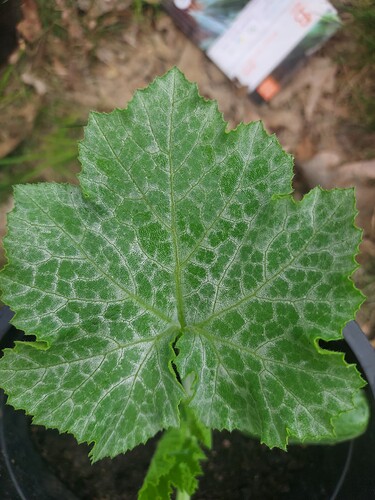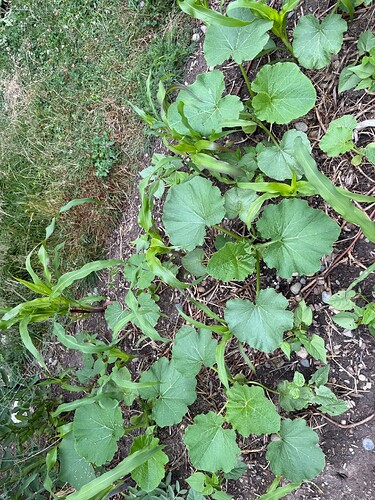It sounds like leaving squash seeds in the soil over the winter helps condition them to the cold. Has anyone else here noticed this?
It is interesting but it has only happened a few times and I don’t think that is enough to draw a conclusion. I generally don’t keep volunteers of something like a squash or watermelon because I must have not liked it or would not have left it to rot in the garden. I did keep a volunteer zucchini last year that turned out very nice, but it wasn’t a frost survivor.
Newer gardener here!
PNW zone 8a, Sandy acidic soil. Mostly dry farming with deep deep wood chip mulch.
Two years ago I direct seeded winter squash and pumpkins into freshly delivered compost and they did amazing! But last year they sprouted and never got bigger than two inches and then died to slugs.
This year I soaked the seeds in a Korean Natural Farming SOS solution and then direct planted them out during our unusually warm spring two weeks before the last frost. I did a better job at putting on some composted chicken bedding I had. I greatly over seeded and many of them have sprouted strong. Here’s hoping that at least a few make it!
Welcome to the community! ![]()
Do blueberries do well in your sandy acidic soil? I have sandy alkaline soil, and they just keep on dying for me. ![]()
All of my planted blueberries are doing great even with my extreme negligence haha. Can’t get a single spinach or cilantro to hardly sprout. Hops are monsters.
Ha ha ha! Which species of winter squash are doing best for you? Pepos seem to do best for me, but I’m finding varieties of moschata and maxima that do well here, too.
Direct seeded my pepo summer squash a week ago, and yesterday direct seeded a maxima grex along with a pole bean landrace into two three-sisters/milpa beds where the corn has mostly germinated.
I have a few more days of nighttime temps just below 50F, and maybe some rain sprinkles, but at the end of this week it looks like we should be heading towards warmer temperatures and less rain. Soil temperatures are averaging about 60F in the morning, higher when we get sun.
I have back up seeds that I’ll plant into any spots that don’t germinate in 10 days or so.
I have yet to plant out my zucchini. There is still a chance of frost here.
I noticed some silvery patterning on the leaves of my starts. I remember that happening last year but the plants still produced just fine. It doesn’t look like the typical moldy white spots of powedery mildew I’ve seen in my own garden and in pictures online:
I’m wondering if some squash just inherently have this pattern. Here are a few pictures.
Here is a picture I found online that is more typical of the powdery mildew I’m used to seeing:
Are these the same thing or a different strain of mildew or is it just a patterning of the leaf?
The first 3 photos look like healthy leaves with silvery patterning. I believe it is common for some varieties. The last photo looks like powdery mildew. Thanks for sharing these photos!
Great! Thanks for the reply. That was my suspicion but I wanted to be sure.
It seemed like my zucchini that had this silvery pattern last year were healthier and more resistant to the powdery mildew so I saved more seeds from those plants.
Has anyone else noticed this?
I should add that I’ve been selecting for yellow/golden zucchini. I wonder if the silvery leaves are more common with those varietys.
I’ve seen it a little bit in my moschata/butternut plants but not nearly as common.
That sounds like good weather for squash. Over here barely have got highs over 15C/59F. Luckily it looks like getting to highs of 20C/68F next week with no frosts expected so that I can start sowing if the forecast holds. Ground is still so cool that they will most likely take a week or more to emerge giving them a bit more time to escape unexpected frosts.
Here’s the second email sent out recently to those who ordered GTS squash mixes. As always, thanks for your comments!
To Cull or Not to Cull
Squash email 2.pdf (5.3 MB)
Thank you for sharing it!
From what I understand, silver in leaves comes from a natural sunblock some plants produce, similar to melanin in humans. So silver patterning in leaves is kind of like freckles! ![]()
I love silver leaves because it tends to be a sign of much more drought tolerant, heat tolerant plants, and that’s something I very much need.
This timing turned out well for me. Generally had good emergence and decent early growth for my area/temperatures.
It has been interesting to observe the difference in vigor/performance between my two beds, though. They are right next to each other, planted at the same time with the same seeds and spacing, but one is rather depleted soil that hasn’t been amended for a couple years and the other had a robust cover crop grown on it over the winter. A really clear demonstration of how squash wants fertility and likes composted organic matter. It’ll be interesting to see what if any production I get out of the neglected soil. The corn and beans it is planted with have been less obviously effected.
Happy squash after a diverse cover crop.
Puny squash in depleted soil.
Here are the rest of the squash articles emailed to people who requested any of the GTS squash mixes:
SquashEmail3.pdf (10.3 MB)
SquashEmail4.pdf (2.5 MB)
SquashEmail5.pdf (6.7 MB)
As always, comments are welcome. Thanks!
Thanks for these emails, Debbie, I always look forward to reading them.
Maarten
We had a very late frost here in Michigan (May 31st). It was pretty devistating to my squash plants. I covered a few but left most uncovered. Almost all the uncovered plants either died or were severely damaged.
There was one single golden zucchini plant that had zero visible damage. It is now setting fruit before any others (Including the covered plants). I’m calling it my golden child lol.
When I’ve search for northern adapted squash seeds in the past, the emphasis always seems to be on fast production in order to fit into a short growing season. I can’t remember ever seeing any claims of frost tollerant squash plants.
Do I have some kind of anomaly here? Did I just get lucky? Does any one else have or heard of squash that can handle frost?
I would guess luck, although there might be some positive traits also. Probably not for frost tolerance per se, but in general to stem/root rot that is most likely what finished of the other plants. Personally I have seen one mild late frost which seemed to be completely random across my plots. Mostly all frost tolerant plants survived it (or missed it), but some areas were more affected. Like 5 tomato plants in a row with damage and hardly in any other of several dozen. So in might be indicative of the fact that temperature in the frost area varies sligtly and for those frost sensitive plants it really makes a difference whether it’s 0.2C under or over. I don’t believe that frost tolerance is a priority in cucurbits. They are so sensitive that it would need to be so slight, which is really hard to control. Sufficiently slight would be like once in 5 years occurence. It would be nice if leaves can be dameged in a frost, but growing tip survives. Still it’s more likely that they die from general coldness and wettness that follows. Or don’t have time to produce.
My answer is that yes, I do think there are Cucurbita squash with relatively better frost resistance, but I’ve never encountered or read about frost resistance that is strong or predictable enough to rely on frost resistance when scheduling plantings.
In my climate, humid mountains in Kentucky (USDA 6b/7a), the timing of the first frost and first freeze generally determine the end of the winter squash growing season. When there aren’t pests or other considerations and only a “frost” is forecast but not a “freeze”, I will often leave squash on the vine.
With the varieties I’ve grown, Cucurbita argyrosperma and C. moschata lose all of their leaves even a mild frost. I have seen C. argyrosperma put on new leaves after this happens, but with either of these two, I don’t expect the plant to survive a frost. I expect to go out and harvest the fruit as the leaves die back.
I have had C. pepo plants maintain leaves through a mild frost, and I’ve seen some indication in my garden and I’ve also read that C. ficifolia and C. maxima can be frost tolerant. But I haven’t yet personally seen those do as well as C. pepo in a gentle frost. I will point out that this could be because I am near or inside the native range of the northern group of wild C. pepo squash.
Your zucchini is C. pepo. I would say it almost certainly has some North American C. pepo DNA, and I would bet its offspring also have greater tolerance of cold and frost.





